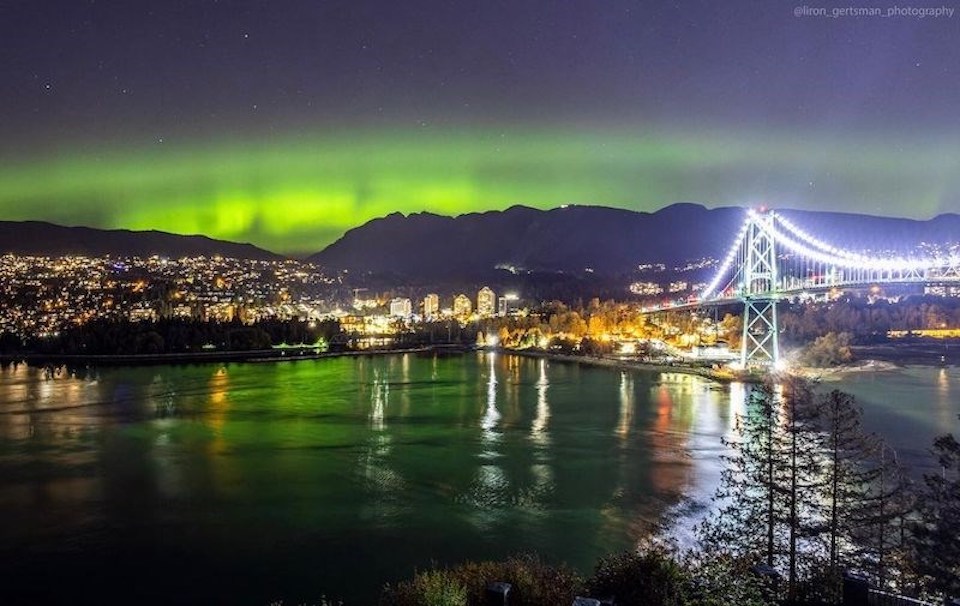Metro Vancouverites observed a spellbinding northern lights display in early May but the geomagnetic storm that caused it wasn't rare.
University of British Columbia (UBC) physics and astronomy professor Mark Halpern says the storm was powerful but not exceptional. Geomagnetic storms of varying intensities happen throughout the year.
The National Oceanic and Atmospheric Administration's (NOAA) Space Weather Prediction Center ranks geomagnetic storms on a scale of minor (G1) to extreme (G5). On May 10, locals were treated to a vibrant display prompted by a severe (G4) storm.
The severe geomagnetic storm was a necessary ingredient in the potent manifestation but a couple of other factors allowed locals to see the vibrant hues.
"It arrived on a clear day," he tells V.I.A., noting that the Lower Mainland has plenty of rainy or overcast days in the spring that wouldn't have provided ideal conditions.
"It was also a new moon so the sky was dark."
When the moon is full or nearly full, the skies aren't always dark enough to observe the aurora's green and purple hues, particularly in the city where light pollution already obscures viewing.
These three factors contributed to ideal viewing conditions but the aurora is active in the region "more often than you might think," Halpern noted.
Since a clear, dark is needed to view the lights, viewing opportunities dwindle heading into the summer as daylight hours increase.
Halpern, who is conducting research in Whitehorse in the Yukon, says people will often mention how the aurora is active and they won't see it despite the northern latitude; the sun sets after 11 p.m. in June and the sky never gets completely dark.
How do you typically see the northern lights in Metro Vancouver?
The Metro Vancouver weather forecast must include a clear sky to view the aurora borealis. You're more likely to observe them during the winter when nights are longer and the sky gets darker. However, viewing opportunities are possible throughout the year (as evidenced by May's electrifying display).
The best time of day to spot them is "astronomical midnight," or when the sun is exactly on the other side of the planet.
Halpern says people see in colour in the day but in black and white at night. As a result, the colours of the aurora often appear grey or milky when looking at the sky.
Locals will be less likely to see the dancing lights downtown. Instead, they should head to the dikes in Richmond, up the Howe Sound, or even more remote areas at UBC that aren't impacted by city lights.
Even areas outside the downtown core, such as Jericho Park, will still experience light pollution from North Vancouver and West Vancouver.
"People take pictures and then notice a green haze later on," he says. "It is visible in Vancouver way more often than you think. If you go out and look up and see a white region that goes and comes back, take a picture."
While a camera with a long exposure is useful for capturing the vibrancy of the aurora, the newest cellphones have a darklight mode that will also capture colours the human eye can't see at night.
What are the northern lights?
The northern lights occur when charged particles (electrons and protons) from the sun collide with gases in Earth's upper atmosphere. This interaction causes them to glow, which creates their trademark green hue.
A solar magnetic storm on the sun causes a geomagnetic storm on Earth. Energetic particles emitted from the sun get caught in Earth's magnetic field but can only arrive on the north and south poles.
"You are seeing our atmosphere react," explains Halpern, adding that the northern lights have been a constant on Earth for millennia. "Dinosaurs would have seen it."
The sun also has an 11-year magnetic cycle and is almost in its more active year.
"It's a bit like hurricane season."
However, scientists continue to learn more about the glowing manifestation and its multi-fold forms.
"The aurora can be super complicated. My daughter was in Nelson with her husband on a small boat and the aurora was in the north but in the south, there was a vertical stripe across the sky moving around," he says.
The UBC geophysics department recently discovered that this "stripe" was solar plasma trapped in Earth's geomagnetic field that generates heat and a current as it moves south, describes Halpern.
His advice to anyone looking to spot the haunting heavenly hues?
"You'll see it if you look more."




